September 21,
2005
By
RALPH BLUMENTHAL
Simon
Wiesenthal, the death camp survivor who dedicated the
rest of his life to tracking down fugitive Nazi war
criminals, died yesterday at his home in Vienna. He was
96.
He died in his
sleep, said Rabbi Marvin Hier, dean and founder of the
Simon Wiesenthal Center in Los
Angeles.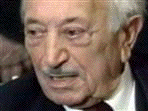
Mr. Wiesenthal had
worked until 2003, when he announced his
retirement.
After hairbreadth
escapes from death, two suicide attempts and his
liberation by American forces in Austria in 1945, Mr.
Wiesenthal abandoned his profession as an architectural
engineer and took on a new calling: memorializing the six
million of his fellow Jews and perhaps five million other
noncombatants who were systematically murdered by the
Nazis, and bringing their killers to justice.
His results were
checkered: claims that he had flushed out nearly 1,100
war criminals were disputed.
But his role as a
stubborn sleuth on the trail of history's archfiends
helped keep the spotlight on a hideous past that he said
too much of the world was disposed to forget.
"To young people
here, I am the last," he told an interviewer in Vienna in
1993. "I'm the one who can still speak. After me, it's
history."
From the cramped
three-room office of his Jewish Documentation Center in
Vienna, Mr. Wiesenthal spent years collecting and
dispersing tips on war criminals through a network of
informants, government agents, journalists and even
former Nazis.
He recounted these
efforts in a memoir published in 1967, "The Murderers
Among Us," and a second volume, "Justice, Not Vengeance,"
in 1989.
With a grave and
tenacious manner, undercurrents of humor and a flair for
gaining attention, he was lionized in 1989 in an HBO
movie "Murderers Among Us: The Simon Wiesenthal Story,"
based on his memoirs and starring Ben
Kingsley.
A character modeled
on him was played by Sir Laurence Olivier in the 1978
film "The Boys From Brazil" (though Mr. Wiesenthal was
mortified by his depiction as a bumbler).
He served as a
consultant for yet another thriller, "The Odessa
File."
Dozens of nations
and institutions honored him: the list of his awards,
typed single-space, takes up nearly an entire dense page.
But one prize that eluded him, to his great
disappointment, was the Nobel Peace Prize.
Defying
Threats and Insults
Mr. Wiesenthal, a
bulky figure with a clipped mustache who sometimes
laughed that people mistakenly saw him as harmless,
pressed his searches despite vilification and threats of
death and kidnapping made against him, his wife, Cyla,
and their daughter, Paulinka. In 1982 his house in Vienna
was damaged by a firebomb, but he escaped unharmed.
(German and Austrian neo-Nazis were charged, and one went
to jail.) Yet he rejected entreaties to move, insisting
that there was a symbolic purpose in doing his work from
a longtime redoubt of Nazism and anti-Semitism where, he
once said, his efforts were "unhappily
tolerated."
|
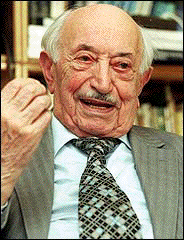
|
|
Simon
Wiesenthal in 1999
[Ronald
Zak/Associated Press]
|
Calling himself "the
bad conscience of the Nazis," he vowed to continue his
efforts "until the day I die." His goal, he said, was not
vengeance but ensuring that Nazi crimes "are brought to
light so the new generation knows about them, so it
should not happen again."
It was a matter of
pride and satisfaction, he said in 1995, as he approached
his 87th birthday, that old Nazis who get into quarrels
threaten one another with a vow to go to Simon
Wiesenthal.
He wrote grippingly
of the German killing industry, cataloging at one point a
list of property sent to Berlin from the Treblinka death
camp between October 1942 and August 1943: "Twenty-five
freight cars of women's hair, 248 freight cars of
clothing, 100 freight cars of shoes," along with 400,000
gold watches, 320,000 pounds of gold wedding rings and
4,000 carats of diamonds "over 2 carats."
In recent years he
spoke out in favor of war crimes trials for genocide in
the former Yugoslavia, and lent his name to a Holocaust
study center and Museum of Tolerance in Los
Angeles.
Sometimes he taught
his lessons with an acerbic wit. Failing to sway a Jewish
lawyer who persisted in defending the right of neo-Nazis
to march even through a Jewish neighborhood, Mr.
Wiesenthal offered a final rebuke: "A Jew may be stupid,
but it's not obligatory."
Once, in West
Germany, he related, he defused a harangue by a speaker
who accused him of dining on Nazis for breakfast, lunch
and dinner. "You are mistaken," he replied. "I don't eat
pork."
He became embroiled
in Austrian politics, feuding bitterly with the Socialist
chancellor, Bruno Kreisky. He was also assailed for
siding with Kurt Waldheim, the former United Nations
secretary general
and
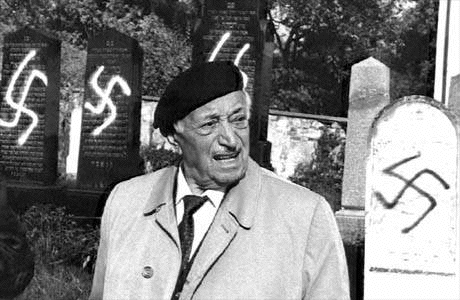
|
|
In
1992, Mr. Wiesenthal at a Jewish cemetery in
Eisenstadt, Austria,
that had been vandalized by right-wing
extremists.
[European
PressPhoto Agency]
|
Austrian president
who concealed his wartime service with a German
intelligence unit implicated in atrocities in the
Balkans.
Critics challenged
Mr. Wiesenthal's claims to have played a role in the
seizure of Adolf Eichmann, who directed the transport of
European Jews to Hitler's death camps and was kidnapped
by the Israelis from Argentina in 1960, then tried,
convicted and hanged.
He also promulgated
many false sightings in the bungled hunt for Josef
Mengele, the Auschwitz death camp doctor who fled to
South America and drowned in Brazil in 1979.
Serge Klarsfeld, a
Paris lawyer who with his German-born wife, Beate, was
instrumental in tracking down the Nazi Gestapo leader
Klaus Barbie in Bolivia, called Mr. Wiesenthal an
egomaniac and faulted him for not supporting their
anti-Nazi demonstrations in South America and Europe. But
Mr. Klarsfeld credited him with blazing the trail by his
early and often lonely quest for justice after the
war.
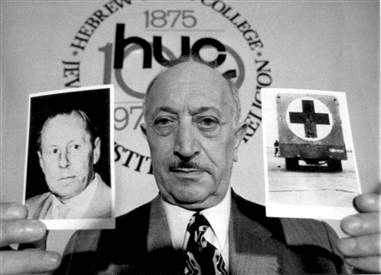
|
|
|
In
1973, Mr. Wiesenthal displayed a photo of the
Nazi fugitive Walter Rauff, responsible for
mobile gas vans that killed thousands of
Jews.
|
Mr. Wiesenthal was
credited with a crucial role in many other cases. His
investigations in São Paulo, Brazil, led to the
arrests of Franz Stangl, former commandant of the
Treblinka and Sobibor death camps in Poland, who was
extradited to West Germany in 1967 and died three years
later while serving a life sentence, and Gustav Franz
Wagner, a former deputy commandant at Sobibor, who died
during extradition proceedings in 1980. He was
instrumental in the arrest and extradition from Argentina
of Josef Schwammberger, an SS officer convicted in the
killings of prisoners and slave laborers at camps in
Poland and sentenced to life in prison in Germany in
1992.
Mr. Wiesenthal
tracked down Karl Silberbauer, at the time a Vienna
policeman, who had been the Gestapo aide responsible for
arresting Anne Frank and her family in their secret annex
in Amsterdam, a feat of sleuthing that buttressed the
credibility of Anne's diary in the face of neo-Nazi
claims that it was fabricated.
He unmasked
Hermine Braunsteiner-Ryan, a whip-wielding guard at the
Maidanek death camp who was living in Queens and who
received a life sentence in West Germany. And he put a
reporter for The New York Times on the trail of Valerian
D. Trifa, a leader of the fascist Iron Guard in
Bucharest, Romania, who fomented a massacre of the Jews,
later found refuge in Michigan as archbishop of the
Romanian Orthodox Episcopate in the United States and was
deported in 1984, to Portugal, where he died three years
later.
Urging
Others to Join In
Mr. Wiesenthal
penetrated veils of secrecy shrouding the Nazi euthanasia
program and doctors who conspired in killing "useless
eaters." He also traced the escape routes of SS criminals
and other Nazis, documenting the underground network
known from its German initials as Odessa. And as much as
tracking down fugitive Nazis himself, he took it as his
mission to goad governments around the world not to drop
their pursuit and prosecution of war
criminals.
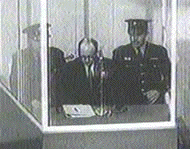
|
|
Adolf
Eichmann
brought to trial in Israel
|
But his efforts in
the hunt for Eichmann and Mengele, two of Nazi Germany's
most heinous criminals, were disputed.
He often claimed to
have placed Eichmann in Buenos Aires as early as 1953,
and later to have turned over crucial photos of Eichmann
to Israeli agents. But Isser Harel, the Israeli Mossad
chief who masterminded Eichmann's abduction, vehemently
contradicted Mr. Wiesenthal, denying that any such
meeting with agents ever took place and crediting the
success to information supplied by a West German
prosecutor, Fritz Bauer. Subsequent accounts lent
credence to Mr. Harel's version.
In the case of
Mengele, wanted for grisly pseudomedical experiments on
twins and other helpless subjects at Auschwitz, Mr.
Wiesenthal had a shrewd insight in 1964. He urged West
German authorities to monitor a close associate of the
Mengele family, Hans Sedlmeier, in Günzburg, a
Bavarian town where the Mengele family had its
farm-machinery business.
Mr. Sedlmeier had
indeed been in regular contact with the fugitive in
Paraguay and Brazil. But he also had friends on the local
police force and, tipped off to a search, concealed
letters and other evidence that would have led to
Mengele. The crucial lead evaporated, not to be
re-examined for more than 20 years, by which time Mengele
was already dead.
Over the years, Mr.
Wiesenthal publicized a host of detailed and spurious
"sightings" of Mengele in Paraguay, Egypt, Spain and a
tiny Greek island, Kythnos. Benjamin Varon, former
Israeli ambassador to Paraguay, publicly suggested that
Mr. Wiesenthal might have been embellishing to coax funds
from contributors. His comments, in a Jewish magazine,
Midstream, in 1983, provoked a rebuke from Mr.
Wiesenthal's supporters, who accused him of "profaning"
Mr. Wiesenthal's "sacred mission."
Although he
continued to voice suspicions of fakery for years after a
body was authoritatively identified as Mengele's in 1985,
Mr. Wiesenthal eventually acknowledged the truth of the
scientific findings that Mengele had indeed drowned and
was quite dead.
Haunting
His Quarry
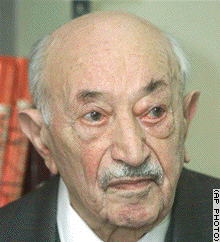
|
|
|
Simon
Wiesenthal in 2002
|
But clearly Simon
Wiesenthal haunted his quarry. One of Mengele's fanatical
Nazi protectors in Brazil, Wolfgang Gerhard, said he had
dreamed of hitching Mr. Wiesenthal to an automobile and
dragging him to his death.
One of the most
rancorous episodes in Mr. Wiesenthal's postwar career
pitted him against Chancellor Kreisky, who was also
Jewish and whom Mr. Wiesenthal accused in the 1970's of
pursuing a politically expedient alliance with former
Nazis to strengthen his Socialist Party. Mr. Kreisky
fired back with intimations that Mr. Wiesenthal had
collaborated with the Gestapo, a charge that
Mr. Wiesenthal labeled ludicrous, and that was never
backed up.
That fracas was
followed a decade later by Mr. Wiesenthal's dispute with
the World Jewish Congress over the Waldheim
affair.
In early 1986, when
the former secretary general ran as the conservative
party candidate for president, the Jewish Congress
investigated his wartime record, uncovering evidence that
he had not sat out most of the war, as he had always
claimed. Instead he had apparently served as a lieutenant
with a German Army intelligence and propaganda unit that
had carried out deportations and atrocities in the
Balkans, and had initialed reports of "severe" measures
to be taken against captives.
From the outset Mr.
Wiesenthal took issue with the allegations, but not for
reasons of politics, he asserted.
"The truth was
simpler," he wrote in his book, "Justice, Not Vengeance."
"I was not prepared to attack Kurt Waldheim as a Nazi or
a war criminal because from all I knew about him and from
all that emerged from the documents, he had been neither
a Nazi nor a war criminal."
In 1993 Eli M.
Rosenbaum, former general counsel of the World Jewish
Congress and later director of the Justice Department
Office of Special Investigations, a Nazi-hunting task
force, linked Mr. Wiesenthal to a Waldheim
cover-up.
In a book,
"Betrayal" (St. Martin's), Mr. Rosenbaum and a co-author,
William Hoffer, wrote that Mr. Wiesenthal, acting on an
Israeli request, had discovered Mr. Waldheim's secret in
French-held war archives as far back as 1979 but for
political or other reasons misled the Israelis. When
evidence of Mr. Waldheim's true record began to emerge,
according to the book, Mr. Wiesenthal allied himself with
Mr. Waldheim to save his own reputation.

|
|
Simon
Wiesenthal in his Vienna Office
in 2000
|
For his part, Mr.
Wiesenthal contended that he had correctly informed the
Israelis that Mr. Waldheim had not been a Nazi party
member nor in the SS, the elite guard, and that the World
Jewish Congress was unfairly trying for its own purposes
to brand Mr. Waldheim a war criminal. While he faulted
Mr. Waldheim's credibility, Mr. Wiesenthal defended his
own conduct. In a world where people believe in Jewish
conspiracies, he told an interviewer, "accusations from
Jewish sources must be able to stand up to all tests of
credibility."
Although a reviewer
for The New York Times took issue with "Betrayal" for
appearing to equate Mr. Wiesenthal and Mr. Waldheim in
villainy, its documentation was widely praised, winning a
jacket endorsement from Elie Wiesel, the Holocaust
survivor and writer.
Imprint
of the Holocaust
Simon Wiesenthal
was born on Dec. 31, 1908, in Buczacz, Galicia, which was
then in the Austro-Hungarian Empire and later became part
of Ukraine. His father, Hans, was a commodities
wholesaler and Austrian Army officer who died in combat
in 1915. In Buczacz, Jews endured murderous pogroms by
the Cossacks, and in one such assault young Simon was
slashed by a marauder's saber. In high school the boy
fell in love with a classmate, Cyla Müller, a
distant relation of Sigmund Freud; though teenagers, they
were considered betrothed.
Mr. Wiesenthal
wanted to study at the Polytechnic Institute in Lvov but
was denied admission because of a quota on Jewish
students. Instead he attended the Technical University of
Prague, where in 1932 he received a degree in
architectural engineering.
|
|
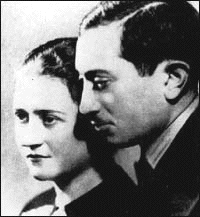
|
|
Simon
Wiesenthal and his wife Cyla in a 1936 portrait.
Eighty-nine members of their families died in
the Holocaust. The couple, believing each other
to be dead, were reunited in late 1945. Cyla
Wisenthal died in 2003 at age 95.
[Courtesy:
Simon Wiesenthal Center]
|
In 1936 he and Cyla
married, and he took a job in an architectural office in
Lvov. Three years later, when Germany and Russia
partitioned Poland, the Red Army overran Lvov, purging
Jews. Mr. Wiesenthal's stepfather was arrested and died
in prison and his stepbrother was shot. Mr. Wiesenthal
was reduced to working as a mechanic in a bedspring
factory. Only by bribing a Soviet secret police
commissar, he wrote, was he able to save himself, his
wife and mother from deportation to Siberia.
In July 1941, Mr.
Wiesenthal recounted, after the invading Germans replaced
the Russians, he and other Jews were lined up in a
courtyard to be shot. After about half the group had been
executed, the soldiers withdrew for a church service and
he was spared. He was then held in the Janowska
concentration camp outside Lvov before he and his wife
were sent to a forced labor camp serving the repair shop
for Lvov's Eastern Railroad.
In 1942, as the
Germans began to carry out their "final solution" by
killing Jews, Mr. Wiesenthal's mother was transported to
the Belzec death camp, where she was killed. In all, Mr.
Wiesenthal and his wife lost 89 family
members.
With false papers
provided by the Polish underground in return for railroad
charts that partisans needed for sabotage, Cyla
Wiesenthal was spirited out of the labor camp in 1942 as
a Pole. She hid in Warsaw, narrowly escaping incineration
in a German flamethrower assault, and was sent to the
Rhineland as a forced laborer making machine guns for the
Germans.
With the connivance
of an official, Mr. Wiesenthal himself escaped the labor
camp in October 1943. But the following June he was
recaptured and sent back to the Janowska camp where, he
related, he slit his wrists with a contraband razor
blade. Revived by the Gestapo for interrogation, he tried
to hang himself but was too weak.
A Long
Trek, Then Liberation
With the Red Army
advancing on the retreating Germans, the SS guards moved
their last remaining 34 prisoners westward, picking up
new prisoners on the march. Few survived the trek, with
stops at the camps in Plasgow, Gross-Rosen and Buchenwald
and ending at Mauthausen in Austria. There Mr.
Wiesenthal, weighing 97 pounds, was liberated by
Americans on May 5, 1945.
Almost as soon as
he could stand, he began collecting evidence on the
atrocities for the War Crimes Section of the United
States Army. He also served the Office of Strategic
Services and the Army's Counter-Intelligence Corps, and
headed the Jewish Central Committee of the United States
occupation zone in partitioned Austria. By the end of
1945 he and his wife had found each other, and the
following year their daughter, Paulinka Kreisberg, was
born.
He is survived by
his daughter, who lives in Herzliya, Israel, and three
grandchildren. His wife died in 2003.
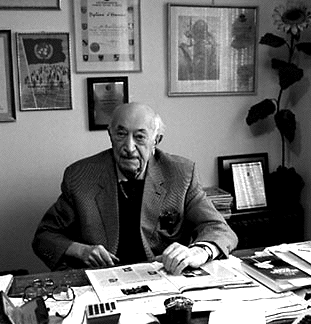
|
|
Simon
Wiesenthal at his office in Vienna, in 2000.
<voirineditions.com/rharchivefoliopages/rharchivefolioportrait12.html>
|
Also in 1946, after
supplying evidence for war crimes trials in the American
zone, Mr. Wiesenthal and 30 volunteers founded the Jewish
Historical Documentation center in Linz, Austria, to
collect evidence for future trials. But the developing
cold war dulled interest in Nazi-hunting - both the
Americans and the Russians were secretly recruiting Nazi
scientists and spymasters. In 1954 the Linz office was
closed and its files conveyed to the Holocaust archives
of Yad Vashem in Jerusalem.
But after the
successful seizure of Adolf Eichmann, for which Mr.
Wiesenthal was quick to claim credit, he reopened his
Jewish documentation center, this time in Vienna, and
focused on an array of notorious Nazi
fugitives.
In November 1977,
Mr. Wiesenthal lent his name to the Simon Wiesenthal
Center, a Los Angeles-based institute for Holocaust
remembrance. With an attached Museum of Tolerance and
offices around the world, the center investigates and
reports on anti-Semitism and bigotry
worldwide.
According to a
biography distributed by the center, Mr. Wiesenthal and
his wife lived in a modest house in Vienna where he spent
his time "answering letters, studying books and files and
working on his stamp collection."
Many European
countries and resistance movements decorated Mr.
Wiesenthal, who was fluent in Polish, German, English,
Yiddish and Russian.
He was often asked
why he had become a searcher of Nazi criminals instead of
resuming a profitable career in architecture. He gave one
questioner this response: "You're a religious man. You
believe in God and life after death. I also believe. When
we come to the other world and meet the millions of Jews
who died in the camps and they ask us, 'What have you
done?' there will be many answers. You will say, 'I
became a jeweler.' Another will say, 'I smuggled coffee
and American cigarettes.' Still another will say, 'I
built houses,' but I will say, 'I didn't forget you.'
"

Copyright
2005 The New York Times Company
.